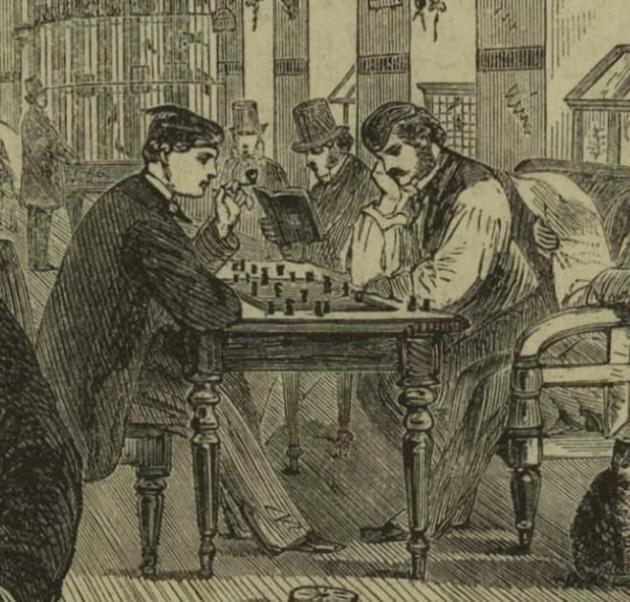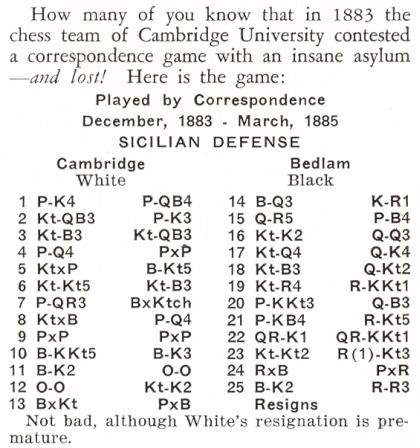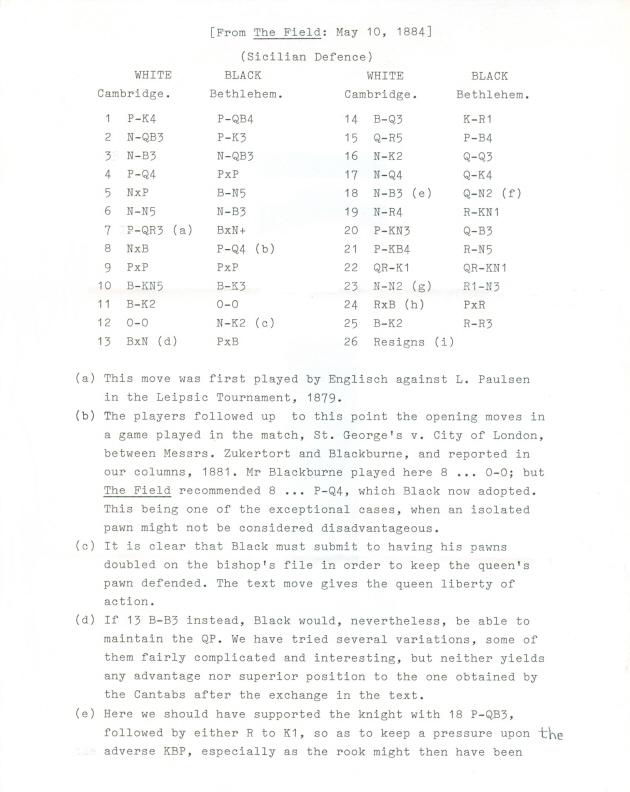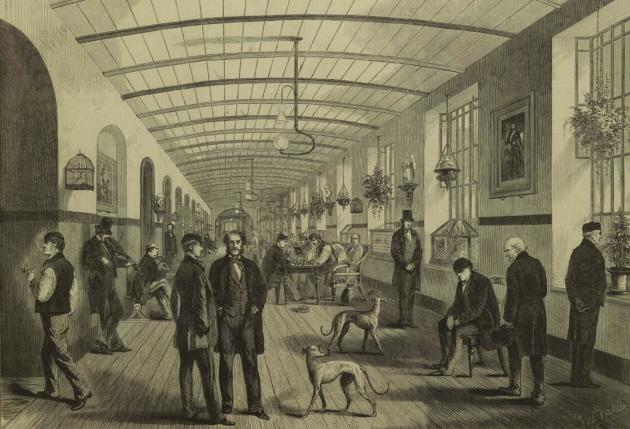
Edward Winter

A letter from T.W. Sweby in the March 1984 CHESS (page 268) mentions in passing that it took two years of correspondence on both sides of the Atlantic to explode the Cambridge University loss of a game to Bedlam Insane Asylum story.
The story we know (item 94 in Chernev’s Wonders and Curiosities of Chess) but not the refutation.
(748)
‘Somewhere’, comments Jack O’Keefe (Ann Arbor, MI, USA), ‘Irving Chernev is smiling’.
In Wonders and Curiosities of Chess (pages 46-47), as well as on page 76 of Chernev and Reinfeld’s The Fireside Book of Chess, it was claimed that ‘Cambridge University once played a game by correspondence with an insane asylum – and lost!’ The moves were given, a Sicilian Defence played ‘1883-1885’, won by Black in 25 moves.

From The Fireside Book of Chess
On page 6 of CHESS, 15 October 1955, T.W. Sweby wrote a short article entitled ‘That “Bedlam beat Cambridge” story’, suggesting that it was spurious. The magazine encouraged Chernev to give the source of his story, and the American wrote a Letter to the Editor on page 41 of the 12 November 1955 issue:
‘In reply to your letter regarding the authenticity of the game between Cambridge University and the Bedlam Lunatic Asylum in 1883:
The score of the game may be found in the October 1937 issue of Chess Review on page 222. I do not recall whether this item has appeared anywhere else, or whether Chess Review alone was the source of my quote, but should I find an earlier mention of this game (or alleged game) I shall be glad to apprise you of it.’
The Editor added: ‘Thanks, Mr Chernev, but we are not much further!’

Chess Review, October 1937, page 222
Mr O’Keefe comments:
‘This lame explanation by Chernev caused widespread skepticism, so that in recent years everyone who has written about the game has regarded it as spurious.
However, when, where and by whom was the game played? The surprising answer can be found in Hoffer’s column in The Field of 10 May 1884, where the game is given with Hoffer’s notes:
“The subjoined game was played between the Cambridge University Chess Club and some gentlemen, patients in Bethlehem Hospital. It commenced early in December 1883, and was finished at the end of March.”
The names of the Cambridge players are unknown. But in a response to the Bedlam player who submitted the game, Hoffer explained White’s early resignation as follows:
“We suppose the brunt of the battle fell to the lot of the two gentlemen you mention, and the task was too much for them during the University week.” (The Field, 29 March 1884)
The Cambridge team against Oxford in 1884 comprised F. Morley, G. Küchler, E.L. Raymond, Rev. W.P. Buncombe, H.W. Sherrard, J.T. Gibson and H. Gwinner; it seems likely that the “two gentlemen” were among them.
Hoffer tactfully did not reveal the names of the Bedlam players, but one was called “Beta”. He also composed problems and contributed two to The Field, (22 December 1883 and 24 January 1885). A game “Beta”-Mr C., “played between two gentlemen, patients in Bethlehem Hospital”, was published on 19 January 1884, and it is plausible that Mr C. (who won the game) might also have played against Cambridge.’
Our correspondent appends the two above-mentioned games, as they appeared in The Field with Hoffer’s notes:


Chernev may indeed smile; his only slip seems to have been the ‘1885’.

The Field, 10 May 1884, page 659
Pro memoria, a quote from The Oxford Reference Dictionary’s entry for Bedlam:
‘bedlam. A scene of wild confusion or uproar. “Bedlam” was originally the popular name of the hospital of St Mary of Bethlehem, founded as a priory in 1247 at Bishopsgate, London, and by the 14th c. a mental hospital. In 1675 a new hospital was built in Moorfields, and this in turn was replaced by a building in the Lambeth Road in 1815 (now the Imperial War Museum), and transferred to Beckenham in Kent in 1931.’
(1891)
Olimpiu G. Urcan (Singapore) draws attention to an illustration published on page 308 of the Illustrated London News, 31 March 1860 as part of a report entitled ‘A Visit to the Royal Hospital of Bethlehem’.

(7783)
B.H. Wood’s column in the Illustrated London News, 24 September 1955, page 540:

The article was reproduced on page 14 of the January 1956 Chess Review.
(10319)
On pages 10-11 of a letter to us dated 17 November 1989 (see too A Debate on Staunton, Morphy and Edge) Frank Skoff criticized Kenneth Whyld’s handling of the ‘Bedlam-Cambridge’ matter:
‘Consider too the unsubstantiated Cambridge-Bedlam game to which K.W. had been seeking an answer for some years (see his BCM 1985 column, page 173). Since he had no evidence for or against its existence, he should have simply stated “I don’t know the answer”. Instead, he dogmatically described it as “an amusing and obviously spurious story”. He also could not help conjecturing and made a “guess”: A game between “Cambridge-Town (?)” and “Bedford (?)”. Now Jack O’Keefe in C.N. 1891 located the hitherto unsubstantiated game in The Field of 10 May 1884, proving again it doesn’t pay to waste space on dogmatism and conjecture.’
To the Chess Notes main page.
To the Archives for other feature articles.
Copyright: Edward Winter. All rights reserved.